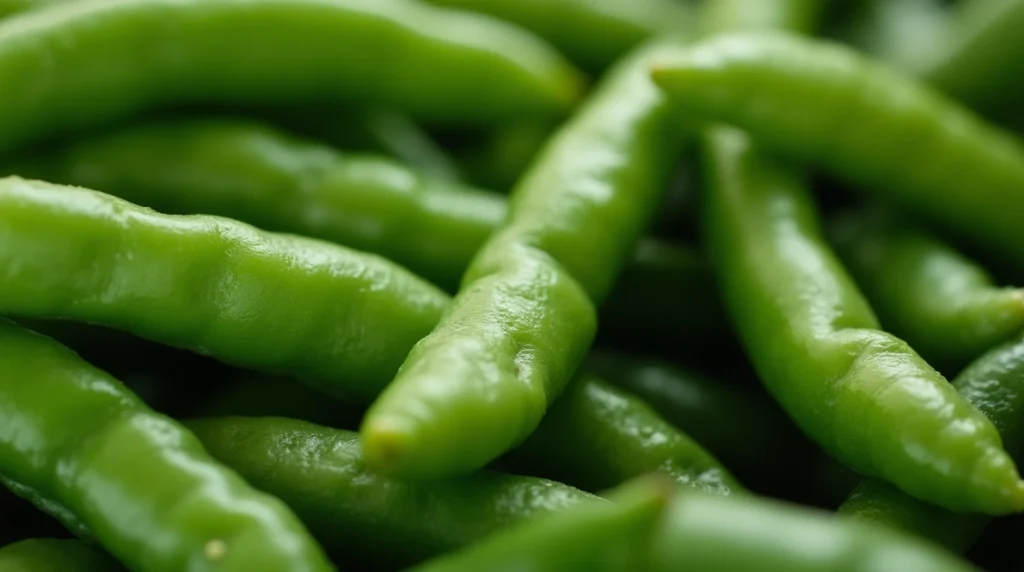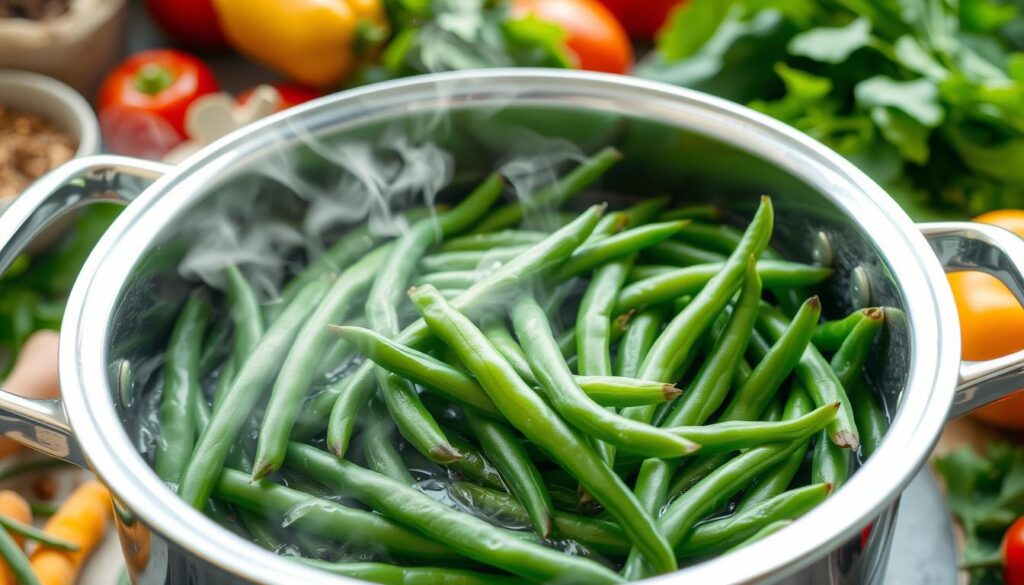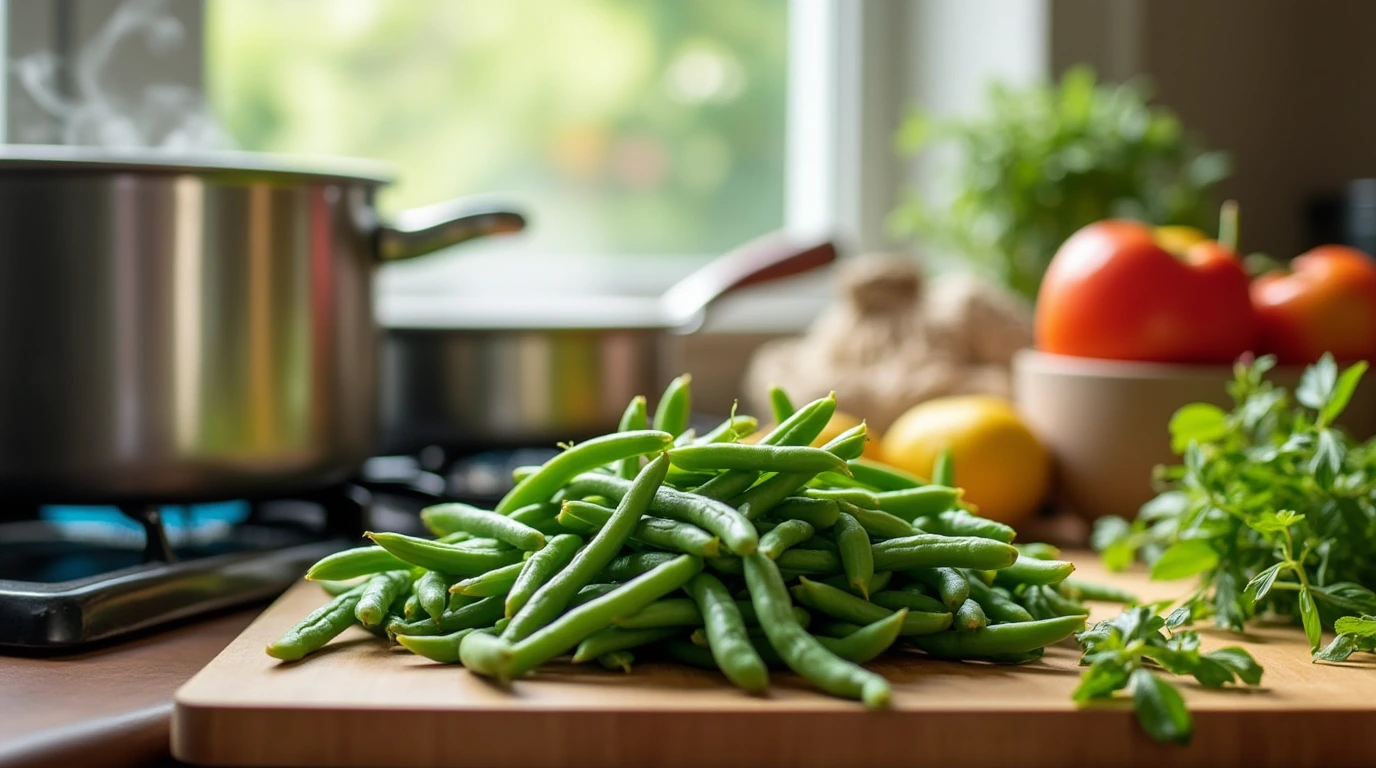Choosing the right way to cook green beans can really change their taste and health benefits. We’ll look at steaming and boiling, two common methods. Steaming keeps more nutrients, but boiling can also make green beans tasty if done right. We’ll cover the health perks and how to make them taste great, including the crack green beans recipe.
Key Takeaways
- Steaming is considered a healthier cooking method than boiling due to lower nutrient loss.
- Steamed green beans can be seasoned with various butters for enhanced flavor.
- Boiling green beans for 3-4 minutes yields tender-crisp results.
- Frozen green beans require longer boiling times because they are already blanched.
- Knowing when to stop the cooking process can prevent overcooking, ensuring the best taste.
- Essential tools, such as a steamer basket and saucepan, are key for perfect steamed green beans.
Introduction to Cooking Methods for Green Beans
Cooking green beans can turn this simple veggie into a tasty dish. Different cooking methods bring out the natural flavors and keep nutrients. Steaming, boiling, or sautéing are top choices, each with its own benefits.
For a long time, fresh green beans were the favorite in kitchens. They taste better and have a nicer texture than canned ones. Green beans are available all year, with the best season from May to October.
Boiling and steaming are great ways to cook green beans. Boiling them in seasoned water makes them tender and flavorful. Steaming is quicker, taking only 3 to 5 minutes, and keeps them crisp and colorful.

Using fresh and firm green beans is key for the best taste. Cooking time ranges from 5 to 10 minutes, depending on the beans’ size and thickness. Adding olive oil, garlic, and spices can make them even more delicious. Try browned butter with almonds or Sriracha with peanuts for a tasty twist.
After cooking, rinse the green beans in cold water to stop the cooking process. This keeps them bright and crunchy. You can also refrigerate them for up to four days or freeze them after washing and cutting the ends. With these tips, you’re ready to explore the world of green beans.
Understanding the Steaming Process
Steaming green beans is easy and keeps them vibrant and full of nutrients. This method is better than boiling because it saves more vitamins. If you want to enjoy the benefits of steaming green beans, learning how to do it right can make your cooking better.
The Benefits of Steaming Green Beans
Steaming keeps green beans crunchy and full of nutrients. It’s a healthier choice than boiling because it doesn’t lose as many nutrients. Steamed green beans are packed with Vitamin C, Vitamin K, and fiber, making them a great choice for a healthy meal.
For example, a small serving of steamed green beans has only 60.38 kcal. They also have carbs, protein, and fiber. This makes them a tasty and nutritious part of any diet.
How to Steam Green Beans Perfectly
To steam green beans perfectly, you need a few tools. A steamer basket is best, but you can also use a colander or pie pan. Here’s how to do it:
- Fill a pot with water, making sure it’s below the steamer basket.
- Boil the water and put the trimmed green beans in the steamer basket.
- Cover and steam for about 15 minutes, until they’re tender but still crisp.
- Add a tablespoon of butter, 1/4 teaspoon of salt, and 1/4 teaspoon of black pepper for flavor.
This way, you get perfectly steamed green beans. You can store them in the fridge for up to four days. This makes them easy to use in different meals. Enjoying steamed green beans can make your meals healthier and tastier.

Exploring the Boiling Method
Boiling green beans is quick and easy, perfect for busy days. It gives a neutral taste that goes well with many seasonings or a bit of butter. This method is loved by many home cooks for its simplicity and speed. Here’s a guide to boiling green beans, showing its benefits and how to get that perfect texture.
Advantages of Boiling Green Beans
Boiling green beans has many benefits, including:
- Quick Cooking: Green beans cook in just 3 to 4 minutes in boiling water.
- Simplified Process: It needs little prep and no special equipment, making it easy for all.
- Flavor Versatility: Boiled beans have a neutral taste, making them great with sauces, spices, or simple seasonings.
Step-by-Step Guide to Boiling Green Beans
Here’s how to boil green beans effectively:
- Prepare the Beans: Rinse fresh green beans under cold water. Cut off the ends to remove any tough parts.
- Boil the Water: Fill a big pot with water and add a pinch of salt. Heat it until it boils.
- Add Green Beans: Gently put the beans into the boiling water. Set a timer for 3 to 4 minutes.
- Check for Tender-Crisp Texture: After the timer goes off, taste a bean. It should be tender but still crisp.
- Drain and Cool: Drain the beans in a colander and cool them in an ice bath. This keeps their color and texture.
Adjust cooking times based on your beans’ size and freshness to avoid overcooking. This way, you’ll get a tasty and healthy side dish.
Should Green Beans Be Steamed or Boiled? A Nutritional Comparison
Choosing the right way to cook green beans is key. We need to look at how steaming and boiling affect their nutrients and taste. Knowing these differences helps us make better food choices.
Nutrient Retention in Steamed vs. Boiled Green Beans
Steaming and boiling green beans change their nutritional value. Boiling can cause a big loss of vitamins like C and B1. Steaming, on the other hand, keeps more nutrients because it doesn’t let them dissolve in water.
For example, steaming broccoli keeps more nutrients than boiling. This is because steaming is gentler and doesn’t let vitamins escape into the water.
| Cooking Method | Nutrient Retention (%) | Impact on Vitamins |
|---|---|---|
| Steaming | High (over 90% for some vegetables) | Minimal leaching of vitamins |
| Boiling | Low (up to 50% loss in antioxidants) | Significant loss of water-soluble vitamins |
Flavor Profiles: Which Method Enhances Taste?
Steaming and boiling change how green beans taste. Steamed green beans are often fresher and brighter. They can be even better with seasonings and sauces.
Boiling makes them softer but can also make them taste less vibrant. Steamed beans are crisper, which some people prefer. For the best taste and nutrition, steaming is usually the better choice.
Flavor Enhancements for Steamed Green Beans
Adding flavor to green beans can make them a tasty side dish. The right seasonings can turn a simple veggie into a standout meal addition. Mixing different ingredients creates a flavor that complements steamed green beans well.
Recommended Seasonings and Ingredients
Here are some ingredients to boost green beans’ flavor:
- Olive oil
- Butter
- Shallots
- Nuts (such as almonds or walnuts)
- Lemon juice
- Sesame oil and sesame seeds
- Herbs like tarragon, dill, and chives
These seasonings not only enhance taste but also add texture and richness. Green beans are low in calories and full of nutrients, making them a great choice for flavoring.
Innovative Recipes: Crack Green Beans Recipe
The crack green beans recipe is a favorite for enhancing green beans. It combines steamed green beans with a mix of savory ingredients. Here’s a quick overview of the recipe:
| Ingredients | Measurements |
|---|---|
| Green beans | 1 pound |
| Butter or extra-virgin olive oil | 1 tablespoon |
| Sea salt | ½ teaspoon |
| Garlic powder | ½ teaspoon |
| Ground black pepper | ¼ teaspoon |
| Lemon juice | 1 tablespoon |
This recipe makes a delicious side dish that’s perfect for any event. The flavors blend well with the green beans, keeping their vibrant color.
Enhancing Boiled Green Beans
Boiled green beans are a tasty and healthy side dish. Adding creative touches can make them even better. By trying different ways to serve them, you can keep their flavor exciting. Simple changes can turn this veggie into a standout dish.
Creative Serving Suggestions
There are many ways to make boiled green beans more interesting. Here are some ideas:
- Drizzle with roasted garlic and olive oil for a rich, savory finish.
- Mix in a few tablespoons of compound butter, enhanced with herbs or spices, for a creamy texture.
- Top with slivered almonds or crushed walnuts for a delightful crunch.
- Incorporate pasta or grains for a more filling dish, tossing the green beans in with the other ingredients.
- Pair with a sprinkle of feta cheese and cherry tomatoes for a refreshing Mediterranean twist.
Ideas to Prevent Overcooking
To keep green beans vibrant and crisp, follow these tips:
- Stick to the recommended cooking time of 5 to 7 minutes for optimal tenderness.
- Avoid overcrowding the pot to ensure even cooking; smaller batches yield better results.
- Employ an ice bath immediately after boiling to halt the cooking process if planning to serve cold.
- Trim the ends before boiling, as this can reduce toughness and enhance the dining experience.
- Consider halving larger beans lengthwise; this method cuts cooking time and enriches flavor.
Common Mistakes: What to Avoid When Cooking Green Beans
When cooking green beans, some mistakes can ruin their taste and texture. Knowing these mistakes can make your dish better and your cooking more enjoyable. Paying attention to how you cook and choose your green beans is key to a great meal.
Overcooking: Signs and Solutions
One big mistake is overcooking green beans. They turn dull and mushy, which is not good. To avoid this, cook them for 4 to 6 minutes if boiling. Blanching and then shocking them in ice water helps keep them green and crunchy.
Here are some tips to prevent overcooking:
- Watch the cooking time to keep them firm.
- Put green beans in an ice bath after boiling to stop cooking.
- Trim the stem ends before cooking to avoid toughness.
Choosing Quality Green Beans for Best Results
Choosing the right green beans is important. They should be firm and bright green. Stay away from beans with bulges or wilting. Fresh beans are usually better than pre-trimmed ones.
Here’s what to look for when picking green beans:
| Criteria | Fresh Green Beans | Pre-Trimmmed Green Beans |
|---|---|---|
| Firmness | Should be firm to the touch | May be less firm |
| Color | Bright, vibrant green | Varies; may be dull |
| Shelf Life | Best consumed within a week | Shorter shelf life, quality may decline |
| Flavor | Optimal freshness and flavor | May not possess the same flavor |
Avoiding these mistakes can make your green beans taste and feel better. With the right cooking and bean selection, your meals will be more enjoyable.
Recommended Tools for Steaming and Boiling Green Beans
Having the right kitchen tools is key when cooking green beans. The best tools for steaming green beans help you get the perfect texture and flavor. They also keep nutrients safe. For boiling, the right utensils can prevent common mistakes and make cooking better.
Essential Kitchen Tools for Steaming
To steam green beans well, you need top-notch tools. These tools are crucial for steaming:
- Steamer Basket: This is a must-have for any kitchen. It keeps beans above the water and lets steam circulate. Make sure it fits well in your pots.
- Microwave-Safe Dish: For a quicker method, use a microwave-safe bowl with a lid. Just adjust the time for your microwave.
- Heavy-Bottomed Pot: A sturdy pot is best for stovetop steaming. It needs a tight-fitting lid to keep steam in.
Best Pots and Techniques for Boiling
For boiling green beans, some techniques and pots make a big difference:
- Large Pot: Pick a pot with lots of room. It helps keep water temperature steady for even cooking.
- Colander or Strainer: A colander is key for draining boiled green beans. It drains well without breaking the beans.
- Salt Water Method: Add a pinch of salt to the water when boiling. It boosts flavor and keeps the beans green.
With the right tools, cooking green beans can be a joy. Here’s a look at some top utensils:
| Tool | Best Use | Benefits |
|---|---|---|
| Steamer Basket | Steaming | Maintains nutrients; provides even cooking |
| Microwave-Safe Dish | Quick Steaming | Convenient and fast cooking method |
| Heavy-Bottomed Pot | Stovetop Steaming | Retains heat; prevents burning |
| Large Pot | Boiling | Ensures even heat distribution |
| Colander | Draining | Easy rinse and drainage |
Conclusion
Green beans can be cooked in two main ways: steaming and boiling. Each method changes how they taste and how nutritious they are. Steaming keeps green beans crunchy and full of color and nutrients.
Boiling makes them soft and quick to cook. But steaming is better for keeping their green color and nutrients. You can choose based on what you like best.
Cooking green beans is simple, and they grow well in home gardens in just 60 days. They are packed with nutrients, making them great for any meal. Trying different recipes and flavors can make them even more exciting.
Whether you like steamed or boiled green beans, both are tasty. Trying new ways to cook them can lead to finding your favorite. So, keep experimenting and enjoy!
FAQ
What is the difference between steaming and boiling green beans?
Steaming uses water vapor to cook green beans. This method keeps more nutrients and flavor. Boiling, on the other hand, submerges them in water. This can lead to nutrient loss.
How long should I steam green beans?
Steaming green beans takes about 4 to 6 minutes. Use a steamer basket or colander over boiling water for the best results.
Can I use frozen green beans for steaming or boiling?
Yes, you can use frozen green beans. Just remember to adjust the cooking time. They might take a bit longer to become tender than fresh beans.
What are some popular seasonings for steamed green beans?
Popular seasonings include butter, lemon juice, garlic, and herbs like thyme or basil. These can enhance the natural flavor of the green beans.
What is a ‘Crack Green Beans’ recipe?
‘Crack Green Beans’ is a popular dish. It elevates green beans with creamy ingredients and seasonings. It often includes cream cheese, bacon, and cheese.
How do I prevent overcooking green beans?
To prevent overcooking, cook green beans until they are tender-crisp. Then, immediately transfer them to an ice bath. This helps maintain their bright color and texture.
Is one cooking method healthier than the other?
Yes, steaming is generally healthier than boiling. Steaming retains more nutrients that can leach into the cooking water when beans are boiled.
What tools do I need to steam or boil green beans?
For steaming, a steamer basket or colander works well. For boiling, a pot large enough to hold water and beans is essential. Both methods benefit from having a lid for quicker cooking.
How do I know if my green beans are of high quality?
Look for firm, bright green beans with smooth skin. Avoid beans that are limp or have blemishes. These may indicate age or poor quality.

